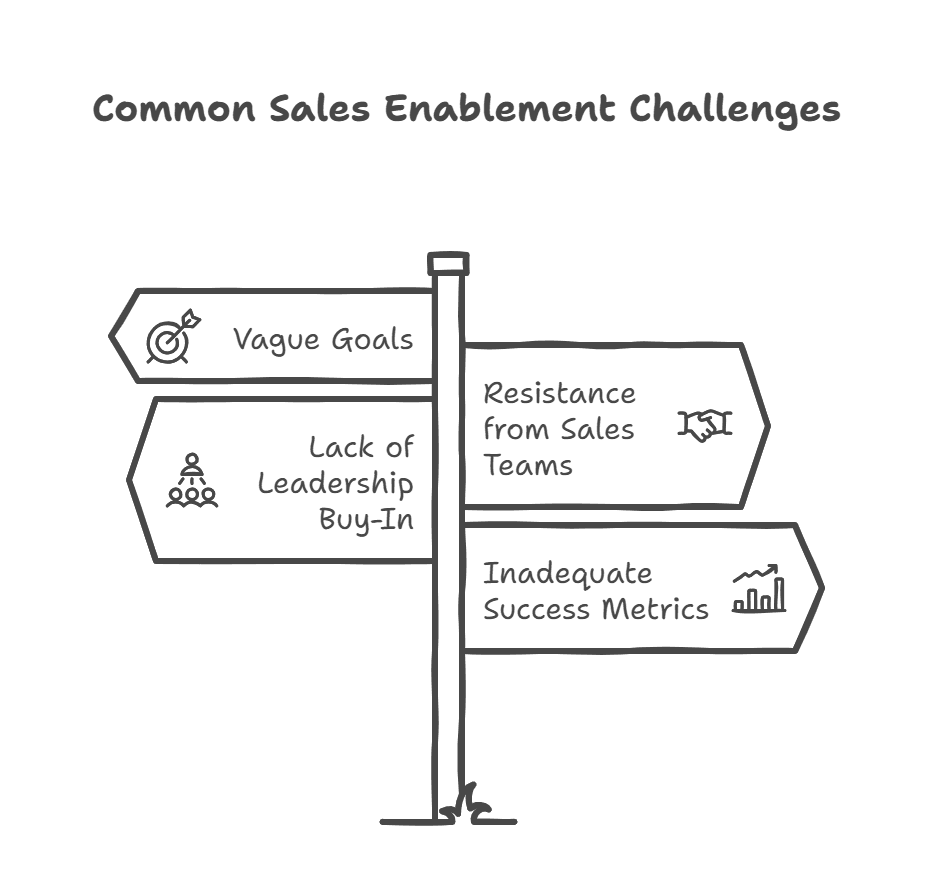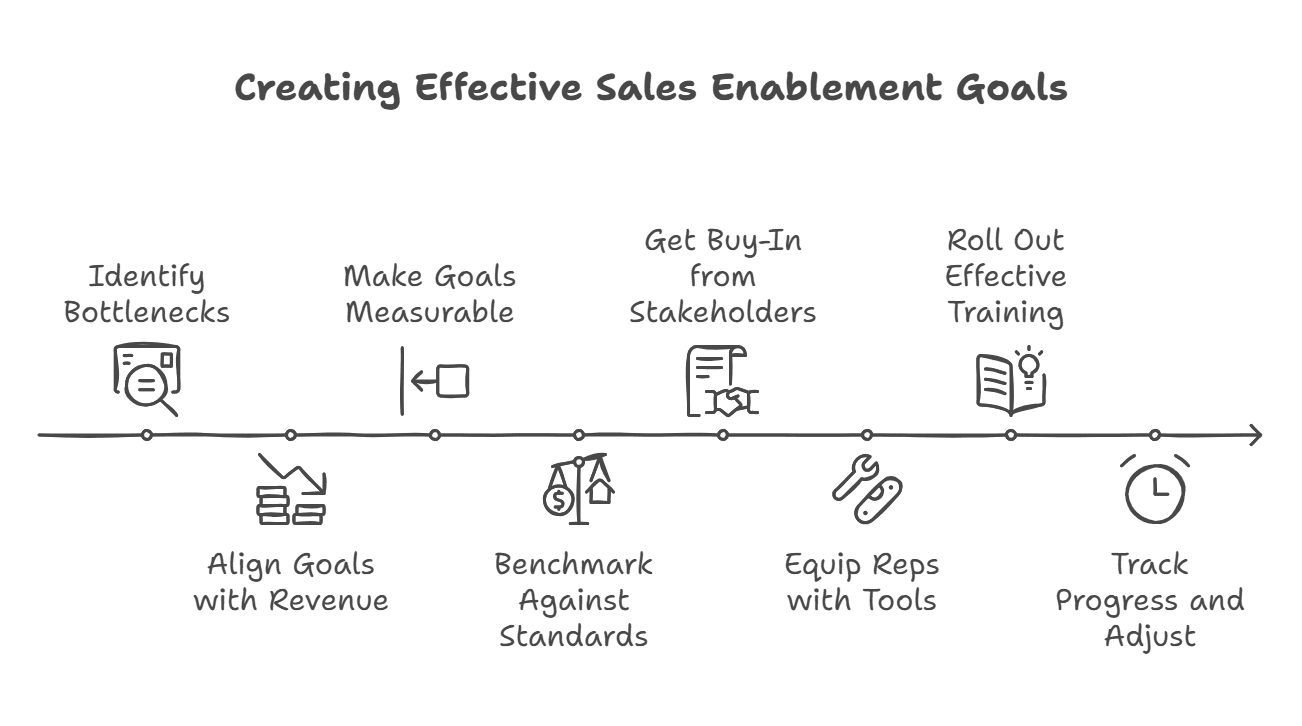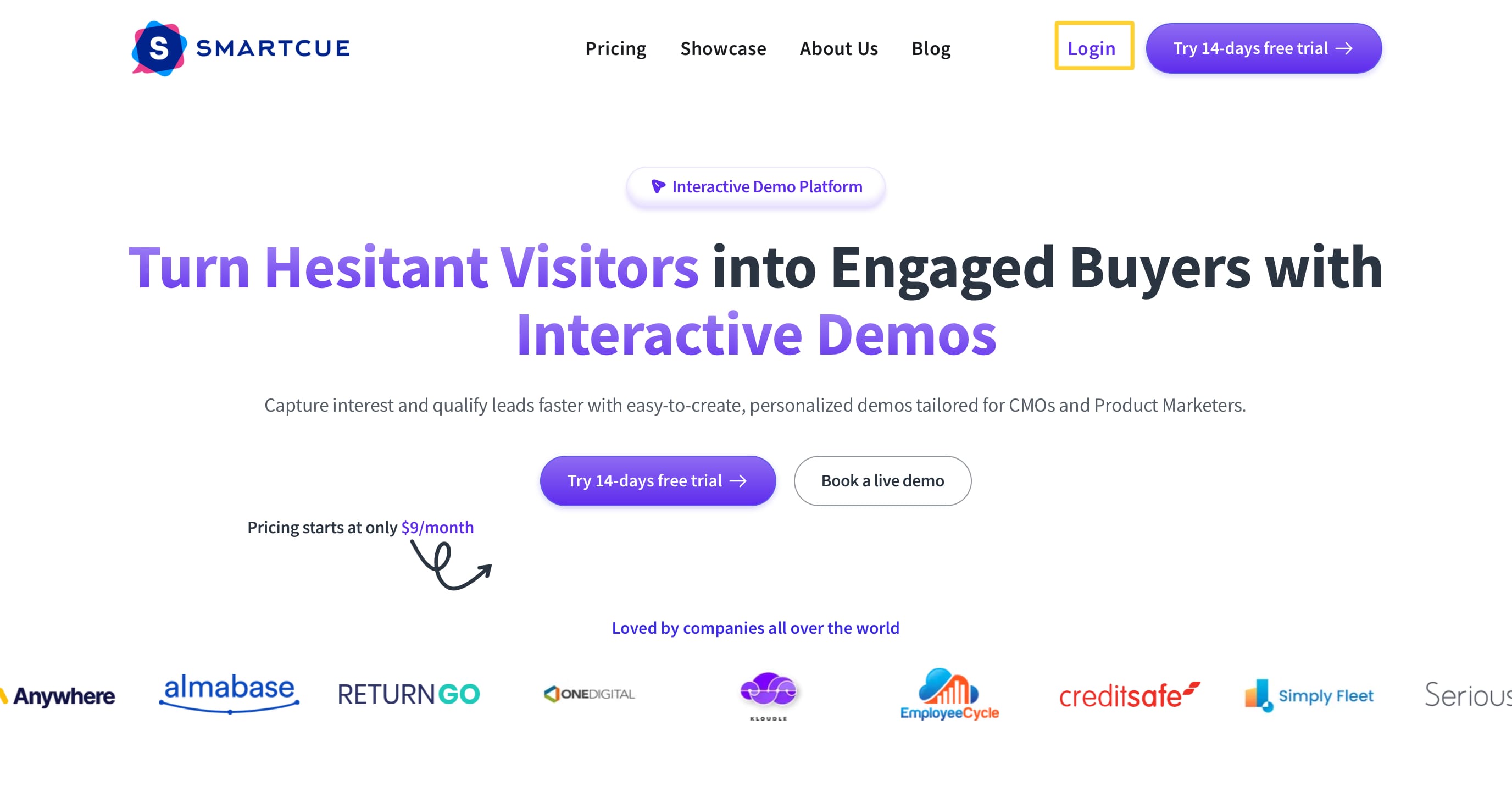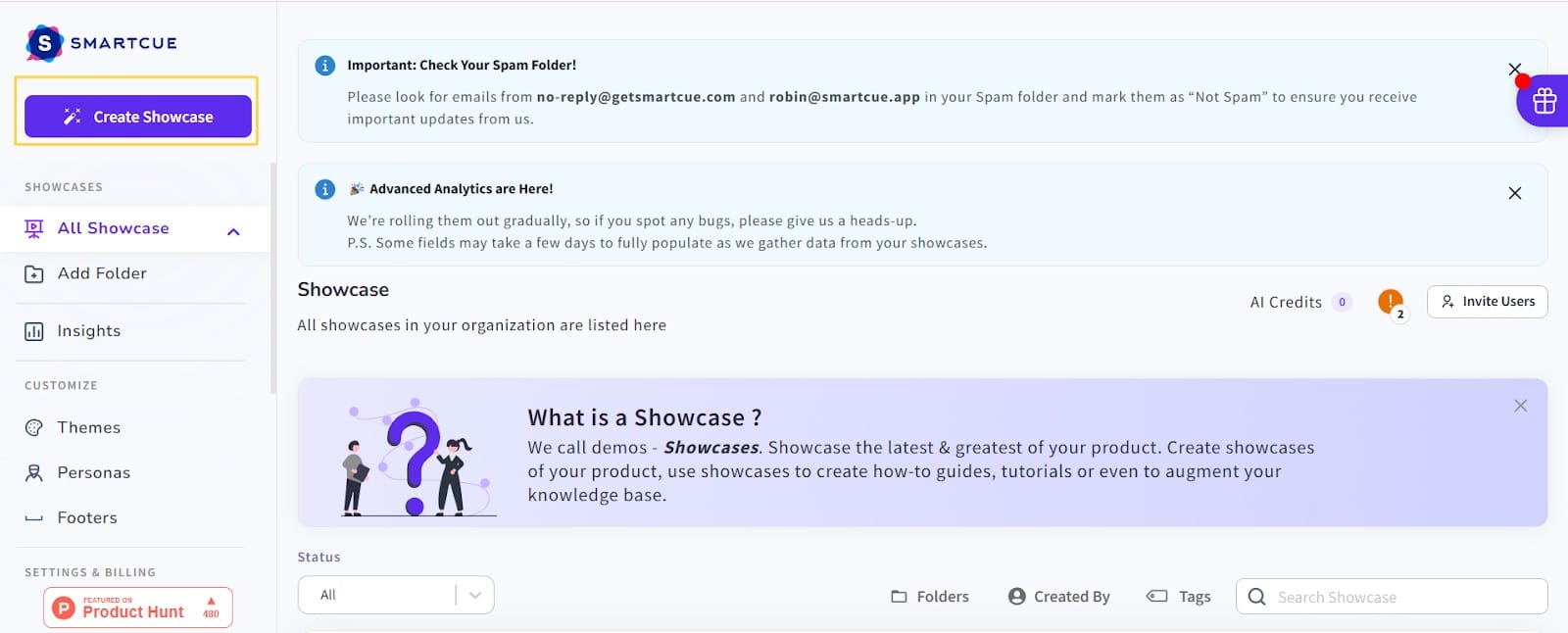How to Create Sales Enablement Goals That Drive Results?
We’ve all been there—pumped about a new sales enablement strategy, convinced it’ll be a game-changer. But fast forward a few months, and nothing has actually changed. Sales reps are still struggling, deals are stalling, and leadership is questioning the ROI.
The truth? Most sales enablement goals are either too vague or completely disconnected from what sales teams actually need to win. If your goals don’t tie directly to revenue, they’re just noise.
So let’s talk about how to set sales enablement goals that actually move the needle.
What Are Sales Enablement Goals?
Sales enablement goals should act as our team's GPS, providing clear direction on what success looks like for our sales professionals. They should inform our reps about:
The skills they need to master – Whether it’s handling objections, negotiating, or qualifying leads, sales reps need defined areas of improvement.
The tools they should be leveraging – From CRM software to AI-driven sales coaching tools, our team should know which resources, including tailored case studies, will help them close deals efficiently.
Strategies to shorten sales cycles – A clear process for follow-ups, overcoming common objections, and managing deal flow helps reps close deals faster.
Techniques to close more deals – The best sales teams aren’t just working harder—they’re working smarter with structured frameworks for engaging and converting prospects.
Why We Set Clear Sales Enablement Goals? (And Why You Should Too)

We've seen it happen too many times, sales teams working hard but not seeing results. Reps are grinding through calls, sending follow-ups, and pushing demos, yet deals keep slipping away. Why? Because effort alone doesn’t close deals, a clear, structured approach does.
But, when we started getting intentional about our goals, everything changed. Our reps started closing more deals, deals moved faster, and our revenue reflected the shift. Here’s why clear sales enablement goals are non-negotiable for us.
1. More Closed Deals
When our team knows exactly what they need to improve, whether it’s mastering objection handling or using effective content for sales, they become more effective, period. We don’t just tell them to "sell better"; we define what selling better looks like and set measurable targets.
For example, instead of saying, “Improve closing rates,” we set a clear goal like: “Increase our close rate from 20% to 30% by Q2 by refining our objection-handling strategy.”
With this approach, our reps have a real target to hit and a roadmap to get there.
2. Shorter Sales Cycles
If deals are dragging, we’re losing. The longer a prospect takes to decide, the more likely they are to walk away or choose a competitor. We made it a priority to reduce deal cycle length by setting goals around follow-ups, lead qualification, and proposal timelines.
Instead of vague goals like, “Speed up the sales process,” we defined: “Reduce average deal cycle from 90 to 60 days by implementing a structured follow-up process with a 24-hour response time.”
Now, our reps know exactly what needs to change, and they have a timeline to make it happen.
3. More Revenue
At the end of the day, every sales enablement initiative we put in place has to meet revenue goals. If we’re spending time and money on training, content, or new tools, we need to see the return.
To make sure our efforts aren’t just activity but real impact, we set goals like: “Increase average deal size by 15% in the next six months by improving upsell and cross-sell strategies.”
This way, we’re not just busy, we’re profitable.
4. A Sales & Marketing Team That Actually Works Together
Sales and marketing misalignment is a revenue killer. If our marketing team isn’t creating content that helps sales close deals, and sales isn’t using the materials marketing produces, we’re wasting time.
So, we set a goal that forced alignment: “Ensure 80% of sales reps actively use marketing-generated content in sales conversations by Q3.”
With that in place, marketing knows what to produce, and sales knows how to use it—no more finger-pointing.
5. Scaling Without the Growing Pains
As we grow, we need to make sure new hires don’t take months to ramp up while experienced reps hit a plateau. Without structured enablement goals, we’d end up with a mix of top performers and struggling reps with no clear path forward.
That’s why we set onboarding goals like: “Reduce new hire ramp-up time from 90 to 60 days by implementing a structured onboarding process with milestone-based training.”
This keeps our team on track and ensures new reps are closing deals faster, not just learning the ropes indefinitely.
The Biggest Sales Enablement Challenges (And How We Fixed Them)

When we first tried rolling out sales enablement goals, it wasn’t smooth sailing. We set targets, expected instant buy-in, and assumed sales productivity would follow. Spoiler alert: they didn’t.
We faced pushback from reps, leadership hesitated to invest, and some of our early goals just weren’t moving the needle. But instead of ditching the process, we refined it. Here’s what we learned—and how we tackled the most common roadblocks.
1. Vague Goals That Don’t Drive Results
Early on, we made the mistake of setting goals that sounded productive but lacked clarity. Broad objectives like “Enhance sales efficiency” or “Improve sales training” felt important, but do not give reps a clear path to success.
How We Fixed It: Tie Every Goal to Revenue
Every enablement goal must be specific, measurable, and directly tied to sales performance. Instead of saying “Improve sales training,” define it like this: “Achieve 90% certification in objection-handling techniques for all reps by next quarter.”
This way, we’re not just focusing on activities, we’re ensuring they lead to more closed deals.
2. Resistance from Sales Teams
When we first introduced structured enablement goals, reps saw them as extra work. The initial reaction was: “Another process to follow? Will this actually help me sell more?”
How We Fixed It: Show Reps What’s in It for Them
Instead of just rolling out new training or tools, make sure reps understood the direct impact on their success. Use real customer data to prove it “Reps who complete objection-handling training see a 20% higher close rate.”
When sales teams see that enablement isn't just busywork but something that could help them close more deals (and earn more commission), buy-in becomes much easier.
3. Lack of Leadership Buy-In
If leadership isn’t fully on board, the sales enablement team won’t get the budget or support it needs. Many times, sales leaders hesitate because the ROI isn’t clear.
How We Fixed It: Prove ROI Before Asking for Buy-In
Before proposing any new enablement initiative, tie it directly to business impact. Instead of saying, “We need a new sales coaching program,” present a data-backed case: “If we reduce onboarding time from 90 to 60 days, we’ll generate an extra $500K in revenue this year.”
When leadership sees the financial upside, approval comes much faster.
4. No Clear Way to Track Success
Even with great goals, without proper tracking, it’s impossible to know what’s working and what needs adjustment.
How We Fixed It: Measure What Matters
Leverage CRM(customer relationship management) data, win rates, and sales cycle durations to monitor progress. Instead of vague metrics like “Increase sales efficiency,” a more defined goal would be: “Reduce average sales cycle from 90 to 60 days and track progress through CRM deal data.”
With measurable benchmarks, sales enablement becomes a strategy, not just an initiative.
Also Read: Sales enablement vs Sales Training: What's the difference?
Step-by-Step Guide to Creating Sales Enablement Goals That Actually Work

Setting sales enablement goals isn't about throwing numbers on a slide and hoping for the best. It requires a structured approach that aligns with revenue enablement, engages key stakeholders, and leverages the right tools for successful sales enablement efforts.
If you want enablement goals that move the needle, here’s the process we follow:
1. Find and Fix the Bottlenecks in Your Sales Process
Before setting goals, take a hard look at where deals are getting stuck. If you don’t identify the weak spots first, you risk creating goals that don’t solve real problems.
Where do reps struggle most—prospecting, handling objections, or closing?
Are deals stalling in specific stages of the pipeline?
Do reps have the tools and content they actually need?
Understanding these pain points helped us set goals that solve real sales challenges—not just ones that sound good in meetings.
2. Align Every Goal with Revenue Impact
A goal that doesn’t drive revenue isn’t a goal—it’s a distraction. If it doesn’t contribute to closing more deals, increasing deal size, or improving conversion rates, it shouldn't be a priority. Ask yourself:
Will this goal help reps close more deals?
Does it speed up the sales cycle?
Can it improve conversion rates at key stages?
If a goal doesn’t pass this test, rethink it.
3. Make Goals Measurable
Goals without clear metrics lead to ambiguity. Every target should be specific and trackable.
Define clear KPIs, metrics, and deadlines—e.g., “Reduce average deal closing time from 90 to 60 days by Q3.”
Monitor progress on a weekly or monthly basis—Regular check-ins prevent the team from going off course.
Make sure every goal has a clear sales success metric so that there is no room for guesswork.
4. Benchmark Against Industry Standards
Setting goals in isolation can lead to unrealistic expectations or underwhelming targets. Benchmarking against competitors and industry best practices helped us set the right bar.
Compare win rates, sales cycles, and deal sizes with industry averages.
Identify areas where the team is falling behind or excelling.
Use benchmarks to set achievable yet ambitious goals that drive real growth.
Using external benchmarks helps us set realistic but ambitious targets that push us forward.
5. Get Buy-In from Reps, Marketing, and Leadership
Sales enablement isn’t just a sales thing. If reps don’t believe in the goals, marketing doesn’t support them, or leadership won’t invest in them, they’ll fail before they even start.
Reps need to see how these goals help them close more deals (and make more money).
Marketing should align content and campaigns with enablement objectives.
Leadership needs to see the ROI before they’ll commit budget and resources.
When all teams are on board, execution becomes 10x easier.
6. Equip Reps with the Right Tools and Resources
We’ve learned that even the best goals fall flat if reps don’t have what they need to succeed. That means:
A CRM that actually works so that there are no more clunky, outdated systems.
Enablement tools that provide real-time coaching and insights.
Content that’s easy to find and use—no more digging through a 50-folder.
Leverage interactive demos with platforms likeSmartCue to create personalized, guided product experiences that help reps showcase value more effectively.
If reps have to fight their tools instead of using them, enablement efforts will fail.
7. Roll Out Training That Actually Sticks
We used to run long, one-size-fits-all training sessions and expect reps to retain everything. Turns out, that’s not how learning works.
Now, we make training:
Bite-sized and continuous learning—Short, focused sessions instead of overwhelming info dumps.
Directly tied to real business goals—If we’re pushing for a shorter sales cycle, training focuses on speeding up deals.
Hands-on and interactive—Role-playing, live coaching, and real-world scenarios work better than slide decks.
8. Track Progress and Adjust in Real Time
Setting a goal and forgetting about it? That’s a recipe for failure. You need to check in regularly to see what’s working, what’s not, and where you need to pivot.
Are key sales metrics (win rates, sales cycle length, deal size) improving?
Are reps engaging with the enablement resources provided?
Do we need to tweak training, tools, or messaging?
Enablement isn’t set-and-forget—it’s a continuous cycle of improvement.
Also Read: Must Have B2B Sales Tools For 2025
Streamline Your Sales Enablement Strategy with Interactive Demos Using SmartCue
Setting sales enablement program goals is one thing—executing them is another. That’s where SmartCue comes in. With interactive, guided demos, SmartCue helps sales teams not only define clear enablement goals but also bring them to life.
Faster Onboarding & Training – Reduce ramp-up time by equipping reps with hands-on, interactive demos instead of static PDFs or slide decks.
Consistent Messaging – Ensure every rep delivers a compelling, standardized pitch without missing key selling points.
Improved Buyer Engagement – Give potential customers a tailored, self-guided product experience that moves them through the buyer journey and sales funnel faster.
Data-Driven Adjustments – Track engagement and demo interactions to refine sales strategies in real time.
With SmartCue, setting sales enablement goals isn’t just about writing them down—it’s about making them actionable, measurable, and impactful. Ready to streamline your enablement strategy? Book a live demo.
How to Record Interactive Demos with SmartCue: A Quick Guide
Creating an interactive demo with SmartCue is quick and easy. Follow these steps:
Step 1: Sign Up & Log In

Start your 14-day free trial and access the SmartCue dashboard.
Step 2: Capture Your Demo

Click ‘Create Showcase’, then choose to either record your screen or upload a file.
Enter the URL of the platform you want to showcase.
Step 3: Record with the SmartCue Chrome Extension
Use the Chrome extension to capture step-by-step interactions.
Pause, delete, or redo steps as needed.
Step 4: Edit & Customize

Enhance your demo using SmartCue’s editing tools—modify text, zoom, blur, or rearrange steps.
Ensure instructions are clear and concise.
Step 5: Publish & Share

Click ‘Publish & Share’ to distribute your demo via email, website, or ads.
In just a few simple steps, you can create an engaging, interactive demo that instantly showcases your product’s value.
Final Thoughts: Unlocking the Full Potential of Sales Enablement
Sales enablement isn’t just about setting goals—it’s about creating a scalable, data-driven strategy that empowers reps, accelerates deals, and enhances the customer experience. When sales enablement leaders align their goals with revenue impact, equip teams with the right tools, and continuously refine their approach, they unlock their team’s full potential.
The difference between struggling teams and those that consistently hit targets comes down to execution. Clear, measurable sales enablement goals are the foundation of successful sales enablement strategy —but only if they’re backed by the right strategy, training, and technology.
If you’re looking for a smarter way to streamline sales enablement and help your team close deals faster, SmartCue’s interactive demos can make all the difference. Get your 14-days free trial, today!
Frequently Asked Questions
1. What makes sales enablement goals effective?
Effective sales enablement goals are measurable, revenue-driven, and aligned with sales operations. They should focus on improving customer interactions, product knowledge, and training programs, ensuring reps have the right content at the right time to move deals forward.
2. How can sales managers ensure reps use sales enablement resources?
Sales managers must integrate sales content and training programs into daily workflows, making them easy to access and apply. Using interactive tools like SmartCue’s guided demos helps reps retain product knowledge and confidently engage with prospects.
3. What role does sales enablement play in customer success?
A strong sales enablement process ensures that reps deliver relevant content and messaging throughout the sales cycle, leading to smoother handoffs, higher retention rates, and better overall customer success in modern sales environments.
4. How do you measure the impact of sales enablement goals?
Tracking key metrics like win rates, deal velocity, and sales enablement content engagement helps determine whether your sales enablement strategy is working. Aligning these insights with sales operations ensures continuous improvement and adaptation to evolving market needs.
Comments
Your comment has been submitted successfully!